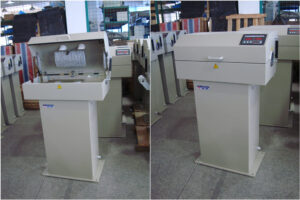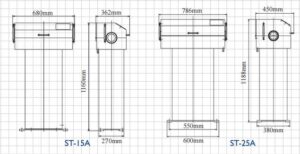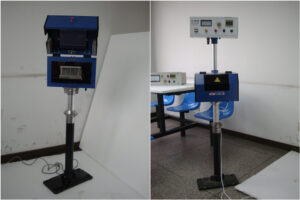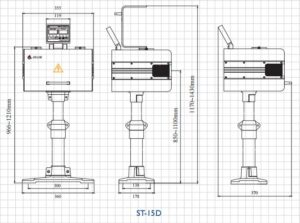Industry Frequency Wire Cable Skin AC Spark Tester
Frequency AC Spark Tester is a special-purpose test apparatus to detect fault of insulation on wire and cable. Integrated with the technology of solid-state AC voltage regulation and single piece microprocessor control, the machine features steady voltage output (unaffected by variation of supply voltage), high sensitivity of fault detection, versatility, user-friendliness, safety and reliability, new construction and beautiful appearance.
The work principle of the spark tester is as follows: Make the tested wire pr cable travel through the high voltage bead-chain electrode having test potential supplied by a commercial frequency HV transformer. If the insulation has fault, breakdown will occur, namely the output of the HV transformer will cause a HV spark short-circuit. The short circuit current flows from the output terminal of the HV transformer through insulation fault-conductor of cable-earth-ground-HV transformer to form a circuit.
Therefor both the spark tester and the conductor of cable shall be soundly earth-grounded otherwise the short circuit cannot be formed and the cabinet of the spark tester and conductor of cable may have high voltage.

Work conditions
Supply voltage:AC220V±10%
Supply frequency:50±2Hz
Ambient temperatures:0~40c°
Relative humidity, max:85% (without condensed water)
Mode of operation: continuous operation
Breakdown indication
Mode of indication: Breakdown count and voice/light alarm
Count range: 0~999
Time duration for voice/light alarm:0.5-15adhustable
Safety interlock
In order to ensure safety for operators, the probe is provided with an interlock switch and a discharge rod .When the front hood is opened, the high voltage is cut off first, then the discharge rod touches the electrode section to discharge the remaining electricity
Supply voltage:AC220V±10%
Supply frequency:50±2Hz
Ambient temperatures:0~40c°
Relative humidity, max:85% (without condensed water)
Mode of operation: continuous operation
Breakdown indication
Mode of indication: Breakdown count and voice/light alarm
Count range: 0~999
Time duration for voice/light alarm:0.5-15adhustable
Safety interlock
In order to ensure safety for operators, the probe is provided with an interlock switch and a discharge rod .When the front hood is opened, the high voltage is cut off first, then the discharge rod touches the electrode section to discharge the remaining electricity
Technical Parameter
|
Type
|
ST-15A
|
ST-25A
|
ST-25AT
|
|
Voltage output
|
1.0-15kV
|
2.0-15kV
|
2.0-15kV
|
|
Voltage indication error
|
<5%
|
<5%
|
<5%
|
|
Detection sensitivity
|
<600μA
|
<600μA
|
<600μA
|
|
Stability
|
Complying with the requirements of GB3048.9-1994 and JB/T 4728.10
|
||
|
Dectection resolution
|
0.05s
|
0.05s
|
0.05s
|
|
Transient breakdown current
|
100mA
|
50mA
|
50mA
|
|
Steady short-circuit current
|
<20mA
|
<20mA
|
<20mA
|
|
Detction Speed, Max
|
300m/min
|
350m/min
|
350m/min
|
|
Overall diameter of tested wire or cable, max
|
≤30mm
|
≤55mm
|
≤100mm
|

Related Machine
DC Spark Tester
ST-15D DC Spark Tester is a useful tool for detection of surface damage as well as for spark test for wire and cable with a
diameter below 10mm. The DC high voltage tester recommended internationally is characterized by advanced design, new construction, steady voltage output, high sensitivity, adaptability, easy operation, versatile mounting, safety and reliability. It may be used for on-line testing in combination with a pair twister or an extruder as well as for intermediate testing and testing for finished products.
The ST-15D compact integrated tester of which the probe ,console display and support make one block, features compact size and easy mounting. It is used mainly for on-line testing in an extruding line with non-centralized control and in combination with a pair twister.
|
Type
|
ST-15D
|
|
Voltage output
|
DC 0-15000V
|
|
Effective test voltage
|
DC 500-15000V
|
|
AC pulse ratio
|
<5%
|
|
Voltage stability
|
The power supply voltage fluctuates by ±15%, and the output voltage remains unchanged
|
|
Breakdown sensitivity
|
<600μA
|
|
Steady-state short-circuit current
|
3-4mA
|
|
Max.frequency of breakdown counting
|
10times/sec
|
|
Max.diameter of the tested wire
|
10mm
|
|
Max.moving speed of the tested wire
|
2800m/min
|

Operational conditions
line voltage: AC220V±15%
Power frequency: 50±2Hz
Power input: 50VA
Ambient temperatures: -10~45ºC
Relative humidity<85% (without condensed water)
Breakdown signal
Mode of operation:Continuous
Auto mode:Audio/visual alarm and breakdown counting
Manual mode:Audio/visual alarm, breakdown counting
and control signal output
Safety interlock
In order to ensure safety for operators, the probe is provided with an interlock switch and a discharge rod.
When the front hood is opened, the high voltage is cut off first, then the discharge rod touches the electrode section to
discharge the remaining electricity.


